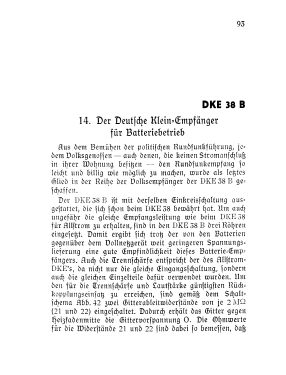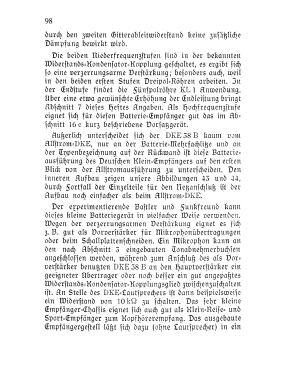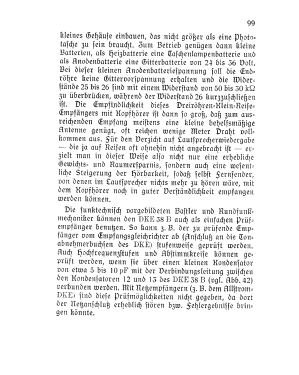Deutscher Kleinempfänger Batt. DKE-38B DKE-1938B
Eumig, Elektrizitäts und Metallwaren-Industrie-Gesellschaft mbH; Wien
- Country
- Austria
- Manufacturer / Brand
- Eumig, Elektrizitäts und Metallwaren-Industrie-Gesellschaft mbH; Wien
- Year
- 1939–1945
- Category
- Broadcast Receiver - or past WW2 Tuner
- Radiomuseum.org ID
- 75358
Click on the schematic thumbnail to request the schematic as a free document.
- Number of Tubes
- 3
- Main principle
- TRF with regeneration
- Tuned circuits
- 1 AM circuit(s)
- Wave bands
- Broadcast (MW) and Long Wave.
- Power type and voltage
- Storage and/or dry batteries
- Loudspeaker
- Magnetic loudspeaker (reed) of high quality (free mooving - only possible past 1931).
- Material
- Bakelite case
- from Radiomuseum.org
- Model: Deutscher Kleinempfänger Batt. DKE-38B DKE-1938B - Eumig, Elektrizitäts und
- Shape
- Tablemodel without push buttons, Mantel/Midget/Compact up to 14
- Dimensions (WHD)
- 240 x 240 x 120 mm / 9.4 x 9.4 x 4.7 inch
- Notes
- Es gibt nur einen Batterie-DKE, aber zweierlei Rückwände: "DKE für Batteriebetrieb" sowohl mit als auch ohne die Jahreszahl 1938.
Siehe auch Deutschland. Normalerweise nur unter Gemeinschaftserzeugnisse geführt.
- Source of data
- Radiokatalog Band 2, Ernst Erb
- Author
- Model page created by Konrad Birkner † 12.08.2014. See "Data change" for further contributors.
- Other Models
-
Here you find 259 models, 229 with images and 177 with schematics for wireless sets etc. In French: TSF for Télégraphie sans fil.
All listed radios etc. from Eumig, Elektrizitäts und Metallwaren-Industrie-Gesellschaft mbH; Wien
Collections
The model Deutscher Kleinempfänger Batt. is part of the collections of the following members.
Forum contributions about this model: Eumig, Elektrizitäts: Deutscher Kleinempfänger Batt. DKE-38B DKE-1938B
Threads: 1 | Posts: 7
I have started working on my DKE38-B. This radio takes three input voltages, +90, +6, and +2. You'd think this should be pretty straightforward. However, looking at the schematic, I am confused. Look at the +6 volt lead (the "+ weiss" line) in the diagram below:
.jpg)
This appears to be connected directly to ground! Surely this cannot be. On the actual radio, this white wire has a little tag that says "+6 v". If I connect my power supply according to this diagram, I will short it out. Can anyone explain this apparent paradox? I want to be sure I don't make a critical error with this radio. Thanks!
Michele Denber, 16.Nov.10



















